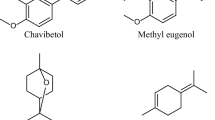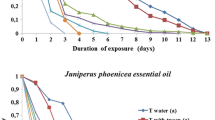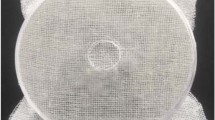Abstract
The black bean aphid Aphis fabae (Hemiptera: Aphididae), the red flour beetle Tribolium castaneum (Coleoptera: Tenebrionidae) and the corn leaf aphid Rhopalosiphum maidis (Hemiptera: Aphididae) are three pests that causes significant economic losses, to several crops, in particular faba bean (Vicia faba), stored products, and maize (Zea mays) respectively. In order to search for readily biodegradable and eco-friendly insecticides, this study aimed to evaluate the efficacy of Lemon verbena Aloysia citrodora (Verbenaceae) essential oil fumigant toxicity against these three pests and identify its chemical composition by gas chromatography–mass spectrometry (GC–MS). The major compounds were Citral (13.80%), D- limonene, (12.16%), Neral (10.67%), Bicyclogermacrene (10.03%), Isospathulenol (6.06%), caryophyllene oxide (5.63%) and p-cymene (4.5%). Significant differences in insect mortality to essential oil vapor were identified in the fumigant toxicity at 48 h exposure time; A. citrodora oil showed higher toxicity on A. fabae (LC50 = 0.011 µl/l air), compared to R. maidis (LC50 = 0.021 µl/l air), followed by T. castaneum (LC50 = 1.149 µl/l air). The present study indicates that A. citrodora essential oil could be employed as a potential insecticide against aphis fabae, Rhopalosiphum maidis and Tribolium castaneum.

Similar content being viewed by others
Abbreviations
- AChE:
-
Acetylcholinesterase
- ANOVA:
-
Analysis of variance
- EO:
-
Essential oil
- GABA:
-
Gamma aminobutyric acid
- GC/MS:
-
Gas chromatography/mass spectrometry
- h:
-
Hour
- LC50:
-
Lethal insecticide concentrations causing 50% mortality. LSD:Fisher’s least significant
- χ2 :
-
Chi square
References
Abbott WS (1925) A method of computing the effectiveness of an insecticide. J Econ Entomol 18:265–267
Abdelgaleil SA, Mohamed MI, Badawy ME, El-arami SA (2009) Fumigant and contact toxicities of monoterpenes to Sitophilus oryzae (L.) and Tribolium castaneum (Herbst) and their inhibitory effects on acetylcholinesterase activity. J Chem Ecol 35:518–525. https://doi.org/10.1007/s10886-009-9635-3
Amer A, Mehlhorn H (2006) Larvicidal effects of various essential oils against Aedes, Anopheles, and Culex larvae (Diptera, Culucidae). Parasitol Res 99:466–472. https://doi.org/10.1007/s00436-006-0182-3
Anonymous (2008) Plant protection technical bulletin, vol I. Ankara, Republic of Turkey Ministry of Agriculture and Forestry. General Dırectorate of Agricultural Research and Policies Publications
Atkins S (2004) Verbenaceae. In: Kadereit JW (ed) Flowering plants · Dicotyledons. The families and genera of vascular plants, vol 7. Springer, Berlin, Heidelberg, pp 449–468. https://doi.org/10.1007/978-3-642-18617-2_25
Bakkali F, Averbeck S, Averbeck D, Idaomar M (2008) Biological effects of essential oils-A review. Food Chem Toxicol 46:446–475. https://doi.org/10.1016/j.fct.2007.09.106
Batish DR, Singh HP, Kohli RK, Kaur S (2008) Eucalyptus essential oil as a natural pesticide. For Ecol Manag 256:2166–2174. https://doi.org/10.1016/j.foreco.2008.08.008
Benzi V, Stefanazzi N, Murray AP, Ferrero A, González JOW (2014) Composition, repellent, and insecticidal activities of two south american plants against the stored grain pests Tribolium castaneum and Tribolium confusum (Coleoptera: Tenebrionidae). . ISRN Entomol. https://doi.org/10.1155/2014/175827
Blackman RL (1974) Invertebrate types: aphids. Ginn & Co, London
Blackman RL, Eastop VF (2000) Aphids of the world crops: an identification and information, 2nd edn. Wiley, Chichester
Bourguet D, Roig A, Toutant JP, Arpagaus M (1997) Analysis of molecular forms and pharmacological properties of acetylcholinesterase in several mosquito species. Neurochem Int 31:65–72. https://doi.org/10.1016/S0197-0186(96)00118-0
Carrasco A, Perez E, Cutillas AB, Martinez-Gutierrez R, Tomas V, Tudela J (2016) Origanum vulgare and Thymbra capitata essential oils from Spain: determination of aromatic profile and bioactivities. Nat Prod Commun 11:113–120
Chang KS, Ahn YT (2001) Fumigant activity of (E)-anethole identified in Illicium verum fruit against Blattella germanica. Pest Manage Sci 58:161–166
Cheng SS, Liu JY, Huang CG, Hsui YR, Chen WJ, Chang ST (2009) Insecticidal activities of leaf essential oil from Cinnamomum osmophloeum against three mosquito species. Bioresour Technol 100:457–464. https://doi.org/10.1016/j.biortech.2008.02.030
Coats JR (1990) Mechanisms of toxic action and structure-activity relationships for organochlorine and synthetic pyrethroid insecticides. Environ Health Perspect 87:255–262. https://doi.org/10.1289/ehp.9087255
Dharmagadda VSS, Naik SN, Mittal PK, Vasudeva P (2005) Larvicidal activity of Tagetes patula essential oil against three mosquito species. Bioresour Technol 96(11):1235–1240. https://doi.org/10.1016/j.biortech.2004.10.020
Don-Pedro KN (1996) Investigation of single and joint fumigant insecticidal action of citruspeel oil components. Pestic Sci 46:79–84
Ebadollahi A, Razmjou J (2019) Chemical composition and toxicity of the essential oils of Lippia citriodora from two different locations against Rhyzopertha dominica and Tribolium castaneum. Agric For 65:135–146. https://doi.org/10.17707/AgricultForest.65.3.11
Enan E (1998) Insecticidal action of terpenes and phenols to the cockroaches: effect on octopamine receptors. Proceedings Int Sym Crop Prot. Gent. Belgium, 5–10 May 1998
Finney DJ (1971) Probit analysis. Cambridge University Press, Cambridge
Gnagey AL, Forte M, Rosenberry TL (1987) Isolation and characterization of acetylcholinesterase from Drosophila. J Biol Chem 262(27):13290–13298
Govindarajan M, Benelli G (2016) Eco-friendly larvicides from indian plants: effectiveness of lavandulyl acetate and bicyclogermacrene on malaria, dengue and japanese encephalitis mosquito vectors. Ecotoxicol Environ Saf 133:395–402. https://doi.org/10.1016/j.ecoenv.2016.07.035
Hori M (1998) Repellency of rosemary oil against Myzus persicae in a laboratory and in a screenhouse. J Chem Ecol 24:1425–1432. https://doi.org/10.1023/A:1020947414051
Isman MB (2006) Botanical insecticides, deterrents, and repellents in modern agriculture and an increasingly regulated world. Annu Rev Entomol 51:45–66. https://doi.org/10.1146/annurev.ento.51.110104.151146
Kaskoos RA (2019) Essential oil analysis by GC-MS and analgesic activity of Lippia citriodora and Citrus limon. J Essent Oil Bearing Plants 22(1):273–281. https://doi.org/10.1080/0972060X.2019.1603123
Keane S, Ryan MF (1999) Purification, characterisation and inhibition of monoterpenes of acetylcholonesterase from the waxmoth, Galleria melonella. Insect Biochem Mol Biol 29:1097–1104. https://doi.org/10.1016/S0965-1748(99)00088-0
Khani A, Basavand F, Rakhshani E (2012) Chemical composition and insecticide activity of lemon verbena essential oil. J Crop Prot 1(4):313–320
Leblanc C, Duval B, Auger Y, Légaré JP (2020) LES PUCERONS DANS LE MAÏS SUCRÉ. In : Le RAP Maïs sucré. Available via DIALOG. https://www.agrireseau.net/documents/Document_102254.pdf. Accessed 26 Mar 2020
Lee BH, Annis PC, Tumaalii F, Choic WS (2004) Fumigant toxicity of essential oils from the Myrtaceae family and 1,8-cineole against 3 major stored-grain insects. J Stored Prod Res 40:553–564. https://doi.org/10.1016/j.jspr.2003.09.001
Marcel V, Palacios LG, Pertuy C, Masson P, Fournier D (1998) Two invertebrate acetylcholinesterases show activation followed by inhibition with substrate concentration. Biochem J 329:329–334. https://doi.org/10.1042/bj3290329
Morais SM, Cavalcanti ESB, Bertini LM, Oliveira CLL, Rodrigues JRB, Cardoso JHL (2006) Larvicidal activity of essential oils from brazilian Croton species against Aedes aegypti L. J Am Mosq Control Assoc 22(1):161–164. https://doi.org/10.2987/8756-971X(2006)22[161:LAOEOF]2.0.CO;2
Mohamed Abdoul-latif F, Ainane A, Mohamed Abdoul-latif T, Ainane T (2020) Chemical study and evaluation of insectical properties of african Lippia citriodora essential oil. J Biopesticides 13(2):119–126
Ozols G, Bicevskis M (1979) Respects for the use of Ips tyrographus attractant. In: Shumakov EM, Chekmenev SY, Ivanova TV (eds) Biologia Aktualis Veshchestva Zashchiva Rastenij. Izd. Kolos, Moscow, pp 49–51
Parker WE, Biddle AJ (1998) Assessing the damage caused by black bean aphid (Aphis fabae) on spring beans. Paper presented at the international Brighton Crop Protection Conference: Pests & Diseases, Brighton, UK, 16–19 November 1998, pp 1077– 1082
Pascual ME, Slowing K, Carretero E, Sánchez MD, Villar A (2001) Lippia: traditional uses, chemistry and pharmacology: a review. J Ethnopharmacol 76:201–214. https://doi.org/10.1016/s0378-8741(01)00234-3
Pimentel MAG, Faroni LRD, Silva FHD, Maurílio MD, Batista DM, Guedes RNC (2010) Spread of phosphine resistance among brazilian populations of three species of stored product insects. Neotrop Entomol 39(1):101–107. https://doi.org/10.1590/S1519-566X2010000100014
Plata-Rueda A, Martínez LC, da Silva Rolim G, Coelho RP, Dos Santos MH, de Souza Tavares W, Zanuncio JC, Serrão JE (2020) Insecticidal and repellent activities of Cymbopogon citratus (Poaceae) essential oil and its terpenoids (citral and geranyl acetate) against Ulomoides dermestoides. Crop Prot. https://doi.org/10.1016/j.cropro.2020.105299
Price DN, Berry MS (2006) Comparison of effects of octopamine and insecticidal essential oils on activity in the nerve cord, foregut, and dorsal unpaired median neurons of cockroaches. J Insect Physiol 52(3):309–319. https://doi.org/10.1016/j.jinsphys.2005.11.010
Pruter C, Zebitz CPW (1991) Effects of Aphis fabae and Uromyces viciae favae on the growth of a susceptible and an aphid resistant cultivar of Vicia faba. Ann Appl Biol 119:215–226
Regnault-roger C, Vincent C, Thor Arnason J (2012) Essential oils in insect control: low-risk products in a high-stakes world. Ann Rev Entomol 57:405–424. https://doi.org/10.1146/annurev-ento-120710-100554
Rice PJ, Coats JR (1994) Insecticidal properties of several monoterpenoids to the house fly (Diptera: Muscidae), red flour beetle (Coleoptera: Tenebrionidae) and Southern Corn Rootworm (Coleoptera: Chrysomelidae). J Econ Entomol 87(5):1172–1179. https://doi.org/10.1093/jee/87.5.1172
Ryan MF, Byrne O (1988) Plant-insect coevolution and inhibition of acetylcholineesterase. J Chem Ecol 14(10):1965–1975. https://doi.org/10.1007/BF01013489
Shannag HK, Ababneh JA (2007) Influence of black bean aphid, Aphis fabae Scopoli. On growth rates of faba bean. World J Agric Sci 3:344–349
Terblanchen FC, Kornelius G (1996) Essential oil constituents of the genus Lippia (Verbenaceae)- a literature review. J Essent Oil Res 8:471–485. https://doi.org/10.1080/10412905.1996.9700673
Tirakmet S (2015) Étude comparative entre l’activité insecticide des huiles essentielles extraites à partir de deux espèces de la famille des Astéracées récoltées dans la région de Makouda et l’activité insecticide d’un pesticide organique de synthèse sur le ravageur secondaire du blé tendre stocké Tribolium castaneum (Coleoptera: Tenebrionidea). Dissertation, University of Mouloud Mammeri Algeria
Tripathi AK, Prajapati V, Khanuja SP, Kumar S (2003) Effect of d-limonene on three stored-product beetles. J Econ Entomol 96(3):990–995. https://doi.org/10.1603/0022-0493-96.3.990
Tripathi Ak, Upadhyay S, Bhuiyan M, Bhattacharya PR (2009) A review on prospects of essential oils as biopesticide in insect-pest management. J Pharmacogn Phytother 1:52–63
Williams MR (2007) Cotton insect losses. In: Proceedings of 2007 Beltwide Cotton Conf; National Cotton Council. Memphis, TN, pp 974–1026
Zoubiri S, Baaliouamer A (2011) Chemical composition and insecticidal properties of some aromatic herbs essential oils from Algeria. Food Chem 129(1):179–182. https://doi.org/10.1016/j.foodchem.2011.04.033
Funding
This study was funded by ministry of higher education and scientific research, Algeria.
Author information
Authors and Affiliations
Contributions
CS conceived the research hypothesis, supervised the research progress, and revised the manuscript.BM designed and performed the experiments and wrote the manuscript. OA performed the bioinformatics analyses and participated in the interpretation; NA participated in experimental work.AO participated in experimental work. KI participated in the interpretation. All authors read and approved the final manuscript.
Corresponding author
Ethics declarations
Financial interests
The authors declare they have no financial interests.
Additional information
Publisher’s Note
Springer Nature remains neutral with regard to jurisdictional claims in published maps and institutional affiliations.
Rights and permissions
Springer Nature or its licensor (e.g. a society or other partner) holds exclusive rights to this article under a publishing agreement with the author(s) or other rightsholder(s); author self-archiving of the accepted manuscript version of this article is solely governed by the terms of such publishing agreement and applicable law.
About this article
Cite this article
Boukabache, M., Chibani, S., Otmani, A. et al. Chemical composition and insecticidal activity of Aloysia citrodora essential oil against Aphis fabae (Hemiptera: Aphididae), Rhopalosiphum maidis (Hemiptera: Aphididae) and Tribolium castaneum (Coleoptera: Tenebrionidae). Int J Trop Insect Sci 43, 455–461 (2023). https://doi.org/10.1007/s42690-023-00949-0
Received:
Accepted:
Published:
Issue Date:
DOI: https://doi.org/10.1007/s42690-023-00949-0




